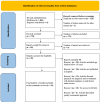Risk Factors Associated With the Development of Calciphylaxis in Patients With Chronic Kidney Disease: A Systematic Review
- PMID: 39776750
- PMCID: PMC11705459
- DOI: 10.7759/cureus.75314
Risk Factors Associated With the Development of Calciphylaxis in Patients With Chronic Kidney Disease: A Systematic Review
Abstract
Calciphylaxis is a rare but potentially life-threatening disease that is not yet completely understood. It occurs mainly in patients with chronic kidney disease termed calcific uremic arteriolopathy (CUA) but also affects patients with normal renal function. Although this disease's pathogenesis is unclear, it is associated with the dysregulation of calcium and phosphate and subsequent calcification of peripheral arterioles. Calciphylaxis has up to 80% mortality, even with multidisciplinary and multimodal treatment modalities. The available literature identified some relevant risk factors associated with the development of calciphylaxis, but the authors differ significantly in risk profiling. Moreover, most papers on calciphylaxis are observational studies, namely case series, case reports, cohort, and cross-sectional studies. Although recently available articles mentioned some risk factors, the studies mainly focused on diagnosis, treatment, and prognosis with limited emphasis on structured risk profiling. In addition, experimental and systemic review studies on risk factors associated with calciphylaxis are lacking. Thus, this systematic review's primary focus is to determine risk factors associated with developing calciphylaxis in patients with chronic kidney disease. We searched electronic databases from 2018 to 2024 for articles that contained relevant risk factors linked with the development of calciphylaxis using the keywords calciphylaxis, chronic kidney disease, and risk factors. We identified 486 articles, removed duplicate papers from selected articles, applied inclusion and exclusion criteria, and conducted a quality assessment test. Two independent authors performed data extraction manually, and we compared the results for consistency and accuracy. Twenty-two articles met the eligibility criteria, but only 16 articles passed the quality assessment appraisal and were included in the systematic review. We identified 1,739 patients: 664 (38.2%) and 1075 (61.81%) were males and females, respectively. A total of 1373 (78.95%) were on dialysis, and 926 (53.25%) were diabetics. Caucasians and patients with obesity were 695 (37.90%) and 613 (35.25%), respectively. At the time of diagnosis, 599 (34.45%), 311 (17.90%), and 278 (15.99%) were on vitamin K antagonists (VKA), vitamin D, and calcium phosphate binders. The number of patients with elevated parathyroid hormone was 196 (11.27%). Our study found no experimental or systematic reviews that primarily focused on risk factors associated with the development of calciphylaxis. Our research indicated that dialysis is the most frequent risk factor linked to the development of calciphylaxis. Other risk factors include being caucasian, female gender, obese, diabetic mellitus (DM), having elevated parathyroid hormone, and use of VKA (warfarin), vitamin D, and calcium phosphate binders. These findings are consistent with the evidence seen in most of the articles we reviewed. However, the papers we studied are mainly observational mono-centered research articles, with the majority having a small sample size. Thus, we recommend a multicenter, large-scale experimental study to assess risk factors and profiling for the development of calciphylaxis in patients with chronic kidney disease.
Keywords: calcific uremic arteriolopathy (cua); calciphylaxis; chronic kidney disease; chronic renal failure; dialysis; dm; end stage renal disease; pth; risk factors; vka.
Copyright © 2024, Ogah et al.
Conflict of interest statement
Conflicts of interest: In compliance with the ICMJE uniform disclosure form, all authors declare the following: Payment/services info: All authors have declared that no financial support was received from any organization for the submitted work. Financial relationships: All authors have declared that they have no financial relationships at present or within the previous three years with any organizations that might have an interest in the submitted work. Other relationships: All authors have declared that there are no other relationships or activities that could appear to have influenced the submitted work.
Figures



Similar articles
-
Calciphylaxis epidemiology, risk factors, treatment and survival among French chronic kidney disease patients: a case-control study.BMC Nephrol. 2020 Feb 26;21(1):63. doi: 10.1186/s12882-020-01722-y. BMC Nephrol. 2020. PMID: 32101140 Free PMC article.
-
Calcific uraemic arteriolopathy (calciphylaxis): data from a large nationwide registry.Nephrol Dial Transplant. 2017 Jan 1;32(1):126-132. doi: 10.1093/ndt/gfv438. Nephrol Dial Transplant. 2017. PMID: 26908770
-
Calcific Uremic Arteriolopathy (CUA) Among Malaysian Dialysis Patients: Clinical Characteristics, Treatment, and Outcomes.Cureus. 2024 Nov 14;16(11):e73711. doi: 10.7759/cureus.73711. eCollection 2024 Nov. Cureus. 2024. PMID: 39677159 Free PMC article.
-
Multidisciplinary approach to calcific uremic arteriolopathy.Curr Opin Nephrol Hypertens. 2015 Nov;24(6):531-7. doi: 10.1097/MNH.0000000000000175. Curr Opin Nephrol Hypertens. 2015. PMID: 26371529 Review.
-
1alpha(OH)D3 One-alpha-hydroxy-cholecalciferol--an active vitamin D analog. Clinical studies on prophylaxis and treatment of secondary hyperparathyroidism in uremic patients on chronic dialysis.Dan Med Bull. 2008 Nov;55(4):186-210. Dan Med Bull. 2008. PMID: 19232159 Review.
References
-
- The Australian Calciphylaxis Registry: reporting clinical features and outcomes of patients with calciphylaxis. Ruderman I, Toussaint ND, Hawley CM, Krishnasamy R, Pedagogos E, Lioufas N, Elder GJ. Nephrol Dial Transplant. 2021;36:649–656. - PubMed
Publication types
LinkOut - more resources
Full Text Sources
Miscellaneous
